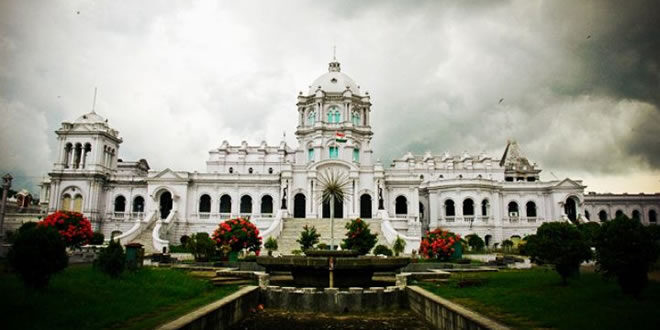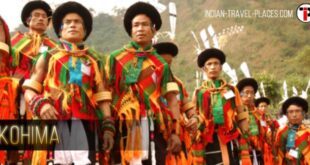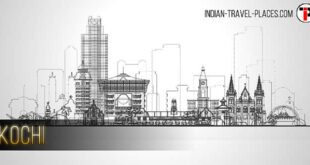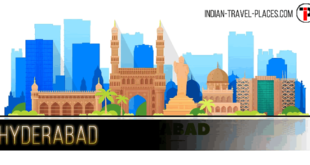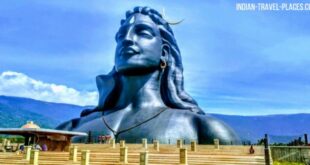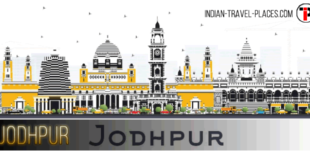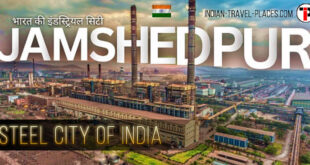| Name: | Agartala (Capital city of Tripura) |
| Location: | West Tripura District, Tripura, India |
| Climate: | Summers: 350 C (Max), 210 C (Min) | Winters: 250 C (Max), 100 C (Min) |
| Best Time to Visit: | October to April |
| Nearest Airport: | Agartala Airport |
| Railway Station: | Agartala Railway Station |
| Must Visits: | Jagannath Temple, Venuban Budhha Vihar, Ujjayanta Palace, Jampui Hills and Neermahal |
| Language Spoken: | Bengali, Chakma, Hindi, English and Kokborok (Tribal Language) |
| STD Code: | 0381 |
Agartala is a striking city tucked in the north-east of India. It is the proud capital of Indian state of Tripura. The city is sited in the western part of Tripura and lies on the swiftly flowing Haroa River. Agartala city is spread over an area of about 59 square kilometres and is situated at an altitude of 13 meters above the sea level. Due to its location, the city has a humid subtropical climate with heavy rainfall all around the year. While summers are hot and wet (April to October), Agartala experiences mild to moderate winters. The best time to visit this city is from the month of October to April. This amazing city has a blend of rich culture and diverse population including various native tribes. Indo-Bangladesh border is just 2 kilometre away from this city and thus, a huge impact of Bengali culture can be seen in locals. This city is very well connected to other cities of India via Railway, Road and Airways.
National Highway No. 44 connects Agartala to Guwahati (599 km) via Shillong. The city also possesses a fully equipped airdrome, Agartala Airport which connects this city to all the major cities of the country such as Delhi, Kolkata and Guwahati, through direct flights. In fact, Agartala is the second capital city (after Guwahati) in the northeast that is linked to the country’s railway network. The city was founded by Maharaja Radha Krishna Kishore Manikya Bahadur (1829-1849) of Manikya Dynasty in 1849, as capital of his empire. In the year 1874-75, it was converted into a municipality under the reign of Maharaja Bir Chandra Manikya (1862-1896). In 1940, this city’s town area was restructured in a planned way to make it a well planned city under the sovereignty of Maharaja Bir Bikram Manikya Bahadur. This is why he is, sometimes, referred to as the founder of the planned city of Agartala.
Agartala is the central market and exporter of various commercial commodities like tea, rice, jute, oil seeds, rubber and gas / LPG for nearby region and states. The main shopping business areas of the city are Gol Bazaar and Kaman Chowmuhani where you can get a variety of handicrafts, wooden articles and other shops, bazaars etc. This vibrant city proves itself to be a wholesome travel destination with its natural beauty, historical palaces and beautiful temples. Some of the prominent tourist spots that you should never miss to visit when in Agartala are College Tilla (Maharaja Bir Bikram College, Tripura University Buildings and landscapes), Ujjayanta Palace (Palace of Tripura Kings) which is now a state legistative assembly, Jagannath Temple, Venuban Budhha Vihar and Neermahal (palace amidst a natural lake, Rudrasagar). Apart from these historical tourist locations, you can take delight in the natural landscapes like Jampui Hill that is called the “Kashmir of Tripura”.
Best Time To Visit Agartala
The sleepy, laid-back city of Agartala poses as a perfect vacation spot for the wearied travelers. Beautiful landscape flanked with rows of bougainvillea shrubs and bright yellow laburnum trees outlining the edges of the streets enhance the exteriors of the city. Agartala has a spate of historical and spiritual attractions that are a sheer visual treat for the tourists visiting this place. A trip to the state museum is a must as the depository displays a slew of images, epigraphs and mementos, which reveal tons about the royal legacy of the state. While you are in the region, do take some time off to familiarize yourself with the local tribal culture, which is a fusion of both Manipuri and Bengali traditions. Dance and music is important to the local people here. The ‘Basanta Raas’ is a delightful dance form performed by the Manipuri folk with great poise and grace and is a must-see attraction of this place. To know more about when to go to Agartala and explore its many attractions, scroll down the article below.
When To Go To Agartala
Weather
Agartala has a humid subtropical climate with hot, wet, clammy summers and brief, balmy winters. Summers in the capital are extremely muggy and hot with temperatures zooming up to 330 C during extreme summer months of March to June. The city receives rampant rainfall from July to October that intensifies the level of humidity in the region. Winters in the city sets in during mid-October and lasts until February. The temperatures during this time drops down to 180 C.
Opting For Your Favorite Seasons
Agartala has long, hot summers and short, pleasant winters. The bright, cheerful, sunny days are good enough to fill one with expectations. But, don’t get carried away by the good summer cheer as the dark grey clouds tend to usually dampen your spirits unexpectedly. So, ensure to carry an umbrella to protect yourself from the harsh sun rays as well as the intermittent showers. Although the summers here last from March to June, you can feel the summer heat even during the monsoon months of July and August when the city is pelted with constant showers. Monsoon in Agartala intensifies during August and September. Towards mid-October, monsoon showers begin to subside and the winter chills sets in the city by November. The landscape of the city becomes more splendid with cool misty breeze and lush green hills adding to its scenic splendors. Winters in Agartala are the best time to make a visit as the weather is ideal for sightseeing during this time.
Best Time To Visit Agartala
The best time to visit Agartala is anytime during the winter months of October to February. As the temperature hits a slump, the natural beauty of the city comes alive. During this season, the city is hoarded with tourists flocking to this place to experience a slice of north-eastern culture. The winter months holds a number of festivities. Since, music and dance is an essential part of the local tribal community here, the celebrations in the region is usually marked by traditional folk dance and songs. Some of the festivals that every tourist should experience during winters are the Orange festival, Diwali and the famous Durga Puja, which is celebrated with grand pageantry of events.
History
Perched on the banks of River Howrah, the low-key capital city of Tripura-Agartala- entices the excursionists and sightseers with its past splendor. With its head-reeling assortment of exciting tourist attractions, a trip to Agartala promises to be nothing short of a joy trip. Erstwhile a princely state, today Agartala stands as a part of the Indian Union. Along with the rich cultural influence and natural beauty, the city is equally renowned for its royal history that testifies to the dominance of Manikya Dynasty in the region. The slew of historical monuments that juts out proudly delineates the imperial grandiosity of the royal families that ruled the land before the city ceded its throne to the British Raj. With a sparse population of nearly 200,000, the city serves as a mini store house of rich diversity, amazing culture, welcoming people and pleasant weather. Go ahead and explore the write-up to know more about Agartala history.
Agartala History
Early History Of Tripura
From the mythological, epigraphic and archaeological evidences excavated by the historians, it is clear that the glory of Tripura is a long-flourishing one. With early references in epic texts like the Mahabharata, the legacy and historical importance of this quaint city can be easily gauged. In the past, Tripura served as the capital to several noted Hindu kingdoms. Although a clear chronology of the rulers is not available, records reveal that the land was formerly ruled by as many as 179 Hindu rulers, starting from mythological King Druhya to the last king of Tripura, Kirit Bikram Kishore Manikya. Apart from the great Hindu rule, Tripura also witnessed the glorious rule of the Mughals. However, with the rise of British power in India, the state came under the governance of English in 1808.
Origin Of The City
Erstwhile, the capital city of Tripura was at Rangamati, the modern day Udaipur in South Tripura. In 1760, Maharaja Krishna Kishore Manikya shifted his capital to ‘Old Agartala’, the present day ‘Khayerpur’ on the banks of River Howrah and named it as ‘Haveli’. However, unable to bear the frequent invasion of Kuki’s and to establish easy communication with the British government in Bengal, Maharaja Krishna Kishore Manikya transferred the capital from ‘Old Haveli’ to ‘New Haveli’ in 1849. Even today, New Haveli ‘serves as the capital of Tripura with the new name ‘Agartala’.
New Image Of City
Maharaja Bir Bikram Manikya Bahadur of Tripura is known as the founder of modern city of Agartala. It was during the early years of forties when the king took initiative to give a new look to the city by completely re-organizing the infrastructure of the city with the newly established roads and buildings.
The Era Of Reformation
With the waves of Indian Independence, the people of Tripura started Ganamukti Parishad movement to include the state as the kingdom of India. The then queen of Tripura Maharani Kanchanprava Devi signed the agreement on 15th October 1949 permitting the government to merge the province with independent India. On July 1, 1963, Tripura became a centrally administered Union Territory and attained the status of full-fledged state on January 21, 1972. Agartala was named as the capital of Tripura.
How To Reach
Tucked away in the extreme corners of northeastern India, the quaint capital city of Tripura — Agartala deserves great applause for holding on to its tribal traditions and regal splendor despite of the growing commercialism in the state. Endowed with nature’s bounties, this erstwhile princely city sashays its manmade creations with great elan. Agartala, which rose to prominence after Maharaja Krishna Manikya declared it the capital of his state, today, this northeastern city is largely admired for its rambling palaces, sprawling gardens, picturesque hills, sanctified shrines and tranquil lakes. The tourists visiting Agartala can get a taste of the diverse culture of the land as the city is flanked by parts of Bangladesh in the north, west and south, Mizoram in the east and Assam in the northeast. A tour to Agartala is most humbling with its famous Ujjayanta Palace, Neermahal, Kunjaban Palace and other rambling royal citadels recounting its regal splendor with perfect poise. If you wish to treat yourself to its natural splendors and spend a few days unveiling its bounties, then trailing this write-up on how to reach Agartala will give you enough information on how to get to the city comfortably and conveniently.
Traveling To Agartala
By Air
Agartala, being the capital city of Tripura, is endowed with an airport of its own. The domestic airport, better known as Agartala Singerbhil Airport, is located at a distance of 12 km to the south eastern side of the city and is apparently the second busiest airstrip in the region after Lokpriya Gopinath Bordoloi International Airport in Guwahati. This airport provides flights to Kolkata, Imphal, Silchar, Delhi, Aizawl, Bangalore, Mumbai, Ahmedabad, Guwahati and several other important destinations. Almost all major domestic airlines like Air India, Kingfisher Airlines, Spicejet, Jet Airways, Indigo Airlines and Air Deccan offer their services from this airport. Being posited in a convenient location, the airport can be easily accessed from the main town by cars, buses and taxis.
By Rail
The Kumarghat Railway Station, located 140 km away from city, is the closest railhead to Agartala. Kumarghat Railway Station is well connected to most of the important northeastern cities as well as other important junctions in the region. Trains like Cachar Express, B.G. Express and Barak Valley Express connects this faraway northeastern city to other destinations in the area. The next closest railhead to Agartala is the Dharmanagar station that is located at a distance of 200 km from the city and can be easily reached by private cabs.
By Road
Agartala is endowed with an excellent network of roads that connect this city to other important destinations in the region. Agartala is connected to Silchar, Shillong, Guwahati, Aizawl, Dharmanagar and other neighboring cities by NH44. Improved inter-state bus services within the state connect the city to remote parts of Tripura as well. What’s more, being located close to Bangladesh, this city is connected to Dhaka by regular bus services. Apart from the private and state bus services, several public and private carriers like jeeps, trekkers, SUVs, cars and vans provide efficient service to the commuters and vacationists. Tourists can hire cycle rickshaws and auto rickshaws to commute within the city. However, if you wish to experience the true flavor of this city, then exploring Agartala by foot is the best way to go about it.
Places To See
Agartala, the princely capital city of Tripura, packs in a perfect punch of history, religion and culture. Thanks to an abundance of royal hotpots like the Ujjayanta Palace, Neermahal, State Museum and Kunjaban Palace, a trip to this northeastern city is perhaps the best way to get up close to the regal grandeur of the place. Like its neighboring northeastern states, everything about Agartala is singular and splendid. It’s a complete package, with everything, right from its customs and cuisine to its nonpareil craftsmanship amplifying its attractions to great heights. Whether it is the famous Orange festival or mind-boggling souvenir stalls, Agartala vaunts of a spate of attractions that reveals oodles about the city. Adding to its charms are tourist hotpots like Laxmi Narayan Bari Temple, Jagannath Temple, Agartala Baptist Church, Pilak and Malancha Niwas, that are absolute must-visit attractions here. Trail this write-up to explore all the major tourist attractions in Agartala.
Tourist Attractions In Agartala
Ujjayanta Palace
The Ujjayanta Palace, former home to the royal family members of the Manikya Dynasty, is an important tourist attraction in the city. Today, however, this majestic monument stands as the legislatively assembly of the state. The palace was built by Maharaja Radhakishore Manikya and named by India’s favorite poet Rabindranath Tagore. Designed by Sir Alexander Martin, this sprawling palace spread across 800 acres of land, boasts of highlights like ‘Throne Room’, ‘Durbar Hall’, ‘Reception Hall’ and ‘Chinese Hall’.
Neermahal
‘Neermahal’, meaning water palace, is located at the centre of the Rudrasagar Lake. This majestic white structure has influences of Indo-Islamic architecture style. The palace was built in 1930 by Maharaja Bir Bikram Kishore Debbarman, the ‘father of modern architecture’ in Tripura. The focal point of the fortress is its huge soaring towers, viaducts, moats and the glimmering reflection of the palace in the water that makes for a breathtaking view. Neermahal palace is posited 53 km away from Agartala.
Kunjaban Palace
The Kunjaban Palace, located near the Ujjayanta Palace, is another architectural jewel of Agartala. The palace is located at a hill-top that gives a panoramic view of the surrounding areas. This spellbinding edifice was built by Maharaja Birendra Kishore Manikya as his summer retreat in the year 1917. While the palace was initially named as ‘Pushbanta Palace’, it was later renamed as Kunjaban Palace. The southern part of the palace is known as Rabindra Kanan and serves as the official residence of the governor of Tripura. Kunjaban Palace was home to many eminent personalities in the earlier days and also to the famous Indian poet Rabindranath Tagore during his final visit to Agartala.
Tripura Government Museum
Located near Chowmohani Post Office, the state museum has a compilation of rare and fascinating artifacts. The state museum was opened by the Directors of the State’s Higher Education in the year 1970. This store house of valuable relics comprises of four art galleries namely, archaeology, tribal, painting and ancient sculptures. On your trip to this museum, look out for gold and silver coins, clothes, jewelry, pottery, copper artifacts, metal sculptures, traditional oil canvass, rare manuscripts in Bengali and Sanskrit etc. which are the pride of state. The museum is opened on all days except on Sundays from 10.00 AM to 5.00 PM.
Bhubaneswari Temple
A visit to Agartala is incomplete without visiting its temples. The temples in the city are an important source of revenue for the tourism department. Even if you are not visiting the place for any religious purpose, it is worth stopping over here to catch a glimpse of its architectural grandeur and its ancient inscriptions. The shrine features a crown shaped stupa with unique floral motifs combined with intricate sculptures, which adds to the splendor of the temple. Bhubaneshwari temple is known for its beautiful sights that is said to be an inspiration for Rabindranath Tagore’s famous plays like ‘Bisharjan’ and ‘Rajarshi’.
Kamalasagar Kali Temple
Also known as the Kasba Kali Bari Temple, this sanctum sanctorum is situated just a few kilometers away from Agartala. The temple is seated on top of a hillock that gives a panoramic view of the Kamala Sagar Lake. The idol of the presiding deity of Goddess Kali is made of sandstone and looks similar to Dasabhujai Durga. As you stroll along the premises of this holy shrine, you will come across many beautiful works of art that represents the 17th century structural designs. The place is also a popular picnic spot among the local inhabitants.
Shopping In Agartala
The historical city of Agartala, with its rich cultural diversity, beckons every visitor to delve deep into its imperial past with great gusto. Boasting of intriguing tribal customs and traditions, this erstwhile princely state, which served as a home to the majestic Manikya Dynasty, is acclaimed for its unpolluted simplicity and exotic natural splendor. Although the real attraction of Agartala lies in its sprawling heritage complexes and hallowed shrines, shopping in the bustling market lanes of the city is a different experience altogether. From exotic handcrafted artifacts made of cane, bamboo, clay and palm leaves to hand-woven fabrics, this erstwhile princely city have plenty to offer to its shoppers. On your trip to this quaint city, don’t skip the chance to hit the busy shopping lanes of Gol Bazaar, Akhaura Road, and Shakuntala Road that forever buzzes with eager sellers and discerning buyers haggling to get the best deals. To explore the main shopping destinations in Agartala, follow the write-up below.
Shopping Places In Agartala
For Handicrafts
Agartala, acclaimed for its exotic handicrafts and handlooms, boast of a unique array of artifacts that cannot to be found anywhere else. The splendor, elegance and attractive designs of these handcrafted wares proudly showcase the creativity and talent of the artisans here. A vast range of products like furniture, table mats, floor mats, partitions, lamp shades and other aesthetic materials can be bought from here at very reasonable rates. Apart from its wooden crafts, the city is admired for its exquisite clay and palm leaves crafts. The ace craftsmanship of Agartala and tribal people has contributed a lot in making their products world-famous. Purbasa, the state government emporium, is the best place to splurge in exquisite handicraft items. Besides this emporium, there are a number of private shops throughout the city, especially in areas like Akhaura Road, Jail Road and Mohanpur, where you can get the best deals on handicrafts.
For Clothes, Accessories And Other Goods
The art of weaving holds a special place in Agartala. Highly influenced by the serenity and traditional lifestyle, the handlooms of Tripura are renowned for their unique combination of contemporary and ethnic designs. The bold color combination and lasting texture of clothes is truly incredible. To get the best bargain on clothes, ‘Tantumita’ emporium is the best place to go. For people willing to splurge in clothes, accessories and goods in Agartala, places like Akhaura Road and Shakuntala Road are ideal. When talking about shopping in Agartala, the exotic market in Bartala needs to be mentioned. Bartala, being the major commercial hub of the city, the market area offers everything from fancy clothes, music CDs to foot wears and funky accessories. The shopping complexes in the city such as Ghar Sansar in Chittaranjan Road and Bazaar Kolkata on Central Road provide all the necessary things.
 ITP Indian Travel Places: Food, Travel, Tourism Business Events and Trade Shows
ITP Indian Travel Places: Food, Travel, Tourism Business Events and Trade Shows
